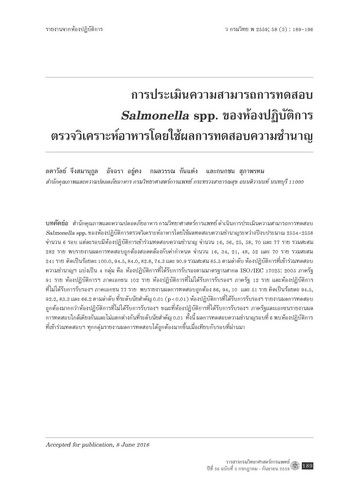Laboratory performance assessment of Salmonella spp. in a food microbiology proficiency testing scheme
Abstract
Bureau of Quality and Safety of Food, Department of Medical Sciences, had conducted the assessment of the competence of food laboratories in testing of Salmonella spp. by using the results from proficiency testing scheme during the fiscal year 2011-2015. The 6 rounds of data were obtained and there were 16, 36, 25, 58, 70 and 77 laboratories participating in each round, respectively. The total number of participating laboratories was 282 labs. It was found that, from 241 labs (85.5% of total labs), the labs that reported the correct results according to the assigned value were 16, 34, 21, 48, 52 and 70 labs which were 100.0, 94.5, 84.0, 82.8, 74.3 and 90.9 percent of the participating labs in the 1st round to the 6th round , respectively. The labs were also divided into 4 groups which were 91 government labs and 102 private labs accredited according to ISO/IEC 17025: 2005, 12 government labs and 77 private labs which had not been accredited. The labs in each group that reported the correct results were 86 out of 91 labs (94.5%), 94 out of 102 labs (92.2), 10 out of 12 labs (84.0%) and 51 out of 77 labs (66.2%), respectively. Accredited labs reported the correct results more than non- accredited labs. The statistical evaluation showed that the competence of accredited labs was significantly different from those of the non-accredited labs (p < 0.01). The competence of both government and private accredited labs was no significantly different. However, the results of the 6th round showed that every groups of the labs reported more correct results when compared with the other rounds.
References
Chapter 36 Salmonella. In: Salfinger Y, Tortorello ML. Compendium of methods for the microbiological examination of foods. 5th ed. Wachington, DC: American Public Health Association (APHA); 2015.
Chapter II, Salmonella infections. In: Bryan FL, Fanelli MJ, Riemann H, editors Food-borne infections and intoxications. 2nd ed. New York: Academic Press; 1979.
Chapter 26, Foodborne gastroenteritis caused by Salmonella and Shigella. In: Jay JM, editor. Modern food microbiology. 6th ed. Gaithersburg, Maryland: Aspen Publishers; 2000. P. 511-530.
WHO. Salmonella (non-typhoidal). [online]. 2013 [cited 2015 Oct 5]; [3 screens]. Available from: URL: https://www.who.int/mediacentre/factsheets/fs139/en
CDC. Foodborne disease active surveillance network: Food Net surveillance report for 2012 (Final report). Atlanta, Georgia: U.S. Department of Health and Human Services, CDC. 2014.
อรทัย สุวรรณไชยรบ, สุทธนันธ์ สุทธชนะ, นริศ บุญธนภัทร, ปณิธี ธัมมวิจยะ, กนิน ธีระตันติกานนท์, กมลทิพย์ วิจิตรสุนทรกุล. สถานการณ์โรคและภัยที่น่าสนใจในรอบสัปดาห์ที่ 1 ปี พ.ศ. 2558. รายงานการเฝ้าระวังทางระบาดวิทยาประจำสัปดาห์ 16 ม.ค. 2558; 46(1): 6-7.
ISO 6579: 2002/Cor.1:2004. Microbiology of food and animal feeding stuffs -- horizontal method for the detection of Salmonella spp. Geneva, Switzerland: ISO; 2004.
Chapter 5 Salmonella. In: Andrews WH, Jacobson A, Hammack T. Bacteriological analytical manual. [online]. 2014 [cited 2015 Oct 5]; [29 screens]. Available from: URL: https://www.fda.gov/Food/FoodScienceResearch/LaboratoryMethods/ucm070149.htm
พระราชบัญญัติอาหาร พ.ศ. 2522 หมวด 4 เรื่องการควบคุมอาหาร มาตรา 25-30. ราชกิจจานุเบกษา เล่ม 96 ตอนที่ 79 ฉบับพิเศษ (13 พฤษภาคม 2522).
ISO/IEC 17025: 2005. General requirements for the competence of testing and calibration laboratories. Geneva, Switzerland: ISO; 2005.
สำนักมาตรฐานห้องปฏิบัติการ กรมวิทยาศาสตร์การแพทย์. นโยบายและหลักเกณฑ์การทดสอบความชำนาญ. SOP No. N 07 15 003 แก้ไขครั้งที่ 08 วันที่ออกเอกสาร 3 ธันวาคม 2557.
กรมวิทยาศาสตร์บริการ. ใบรับรองความสามารถผู้จัดโปรแกรมการทดสอบความชำนาญห้องปฏิบัติการ. ที่ วท 0303/783 ออกให้ ณ วันที่ 26 มกราคม 2558.
ลดาวัลย์ จึงสมานุกูล, กมลวรรณ กันแต่ง และอัจฉรา อยู่คง. การพัฒนาการเป็นผู้ดำเนินการแผนทดสอบความชำนาญการตรวจวิเคราะห์อาหารทางจุลชีววิทยา. ว กรมวิทย พ 2558; 57(2): 127-41.
ISO/TS 22117: 2010. Microbiology of food and animal feeding stuffs -- specific requirements and guidance for proficiency testing by interlaboratory comparision. Geneva, Switzerland: ISO; 2010.
ISO/IEC 17043: 2010. Confomity assessment -- GeneraI requirements for proficiency testing. Geneva, Switzerland: ISO; 2010.
บทที่ 10 การวิเคราะห์แบบไคสแควร์. ใน : วัชราภรณ์ สุริยาภิวัฒน์. สถิติสำหรับวิทยาศาสตร์ชีวภาพ เล่ม 2. กรุงเทพฯ : จุฬาลงกรณ์มหาวิทยาลัย, 2552. หน้า 183-226.
นวพร อนันตสินกุล. สถิติสำหรับงานวิเคราะห์ทางเคมีและการทดสอบความชำนาญ. นนทบุรี : กรมวิทยาศาสตร์การแพทย์ กระทรวงสาธารณสุข; 2554.

Downloads
Published
How to Cite
Issue
Section
License

This work is licensed under a Creative Commons Attribution-NonCommercial-NoDerivatives 4.0 International License.


